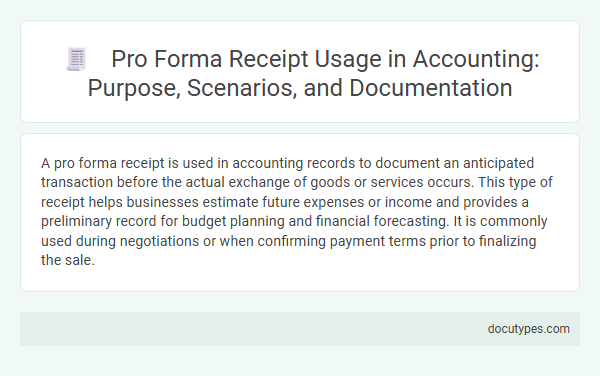A pro forma receipt is used in accounting records to document an anticipated transaction before the actual exchange of goods or services occurs. This type of receipt helps businesses estimate future expenses or income and provides a preliminary record for budget planning and financial forecasting. It is commonly used during negotiations or when confirming payment terms prior to finalizing the sale.
Introduction to Pro Forma Receipts in Accounting
| Topic | Details |
|---|---|
| Definition of Pro Forma Receipt | A pro forma receipt is a preliminary document issued to acknowledge the receipt of goods or services before the final invoice is generated. |
| Purpose in Accounting | Used to record anticipated transactions in accounting records, ensuring accurate financial tracking and internal controls before actual payment or formal invoicing. |
| When It Is Used | Commonly issued when goods are shipped or services provided but final pricing or billing details are not yet confirmed. |
| Role in Financial Statements | Helps maintain temporary records for accounts payable or receivable until official documents validate the transaction. |
| Benefits | Enhances transparency, improves cash flow management, and assists in budgeting by reflecting pending transactions in accounting books. |
| Example Scenario | A company receiving a shipment with an expected price but awaits final supplier billing uses a pro forma receipt to record the inventory and corresponding liability. |
Defining Pro Forma Receipts: Key Features
A pro forma receipt is a preliminary document issued to acknowledge a transaction before the final payment or official receipt is generated. It serves as a temporary record in accounting to track expected payments or goods delivery.
Key features of a pro forma receipt include its provisional nature, lack of legal enforceability, and use primarily for internal record-keeping. It outlines the details of the transaction, such as the amount, date, and description of goods or services, but does not confirm final payment. Your accounting records can use pro forma receipts to forecast cash flow and verify pending transactions efficiently.
Primary Purposes of Pro Forma Receipts
A pro forma receipt is used in accounting to document a transaction before the final sale is completed. It serves as a preliminary record for both the buyer and seller during ongoing negotiations or project planning.
- Estimate Transactions - Pro forma receipts provide an estimated value of goods or services to assist in budgeting and financial forecasting.
- Facilitate Approvals - These receipts are used to obtain internal approvals or client consent before formal invoicing or delivery.
- Record Intent - They document the intent to purchase or sell, helping to clarify terms and expectations prior to finalizing transactions.
Common Scenarios for Pro Forma Receipt Usage
When is a pro forma receipt used in accounting records? A pro forma receipt is typically used before the actual sale or transaction is completed, providing an estimated record of goods or services. This document helps businesses and clients anticipate costs and track potential revenue.
What are common scenarios for pro forma receipt usage? Pro forma receipts are often used in international trade to outline terms before shipment, during prepayments to confirm amounts owed, and when issuing preliminary invoices for budgeting purposes. Your accounting team can use these receipts to maintain transparency and accuracy in financial planning.
Pro Forma Receipts vs. Standard Receipts
A pro forma receipt is used in accounting records to acknowledge a transaction before the final payment is received or before the official invoice is issued. It serves as a preliminary document outlining the estimated costs or goods to be delivered.
Standard receipts are issued after payment and act as official proof of a completed transaction. These receipts include actual payment details, tax information, and confirm that the exchange of goods or services is finalized.
Step-by-Step Documentation of Pro Forma Receipts
A pro forma receipt is used in accounting records to document anticipated transactions before the actual payment is received. This helps businesses maintain accurate financial projections and prepare for incoming revenue.
Begin by creating the pro forma receipt with detailed information about the goods or services, including quantities, prices, and expected payment dates. Record this document in the accounting system to track potential income and support future financial reconciliation.
Essential Elements of a Pro Forma Receipt
A pro forma receipt is used in accounting records to provide a preliminary acknowledgment of a transaction before the final sale is completed. It serves as a non-binding document that outlines the expected goods or services, estimated prices, and payment terms. Essential elements include the seller's and buyer's details, a clear description of items or services, estimated costs, and the date of issuance.
Benefits of Pro Forma Receipts in Financial Processes
A pro forma receipt is used in accounting records to document estimated transactions before the final invoice is issued. It helps businesses track anticipated payments and arrange financial planning more accurately. You benefit from improved cash flow management and enhanced transparency in your financial processes using pro forma receipts.
Best Practices for Managing Pro Forma Receipts
Pro forma receipts are used in accounting records to document preliminary transactions before final payment or delivery. They help track expected expenses and revenues without affecting official financial statements.
- Use Pro Forma Receipts for Estimated Transactions - These receipts capture anticipated costs or revenues prior to confirmed invoicing to maintain accurate forecasting.
- Clearly Label Pro Forma Documents - Marking receipts as "pro forma" prevents confusion with finalized receipts and ensures proper accounting treatment.
- Review and Update Pro Forma Records Regularly - Regular assessment aligns preliminary data with actual transactions, maintaining accounting accuracy and transparency.
When Is a Pro Forma Receipt Used in Accounting Records? Infographic

